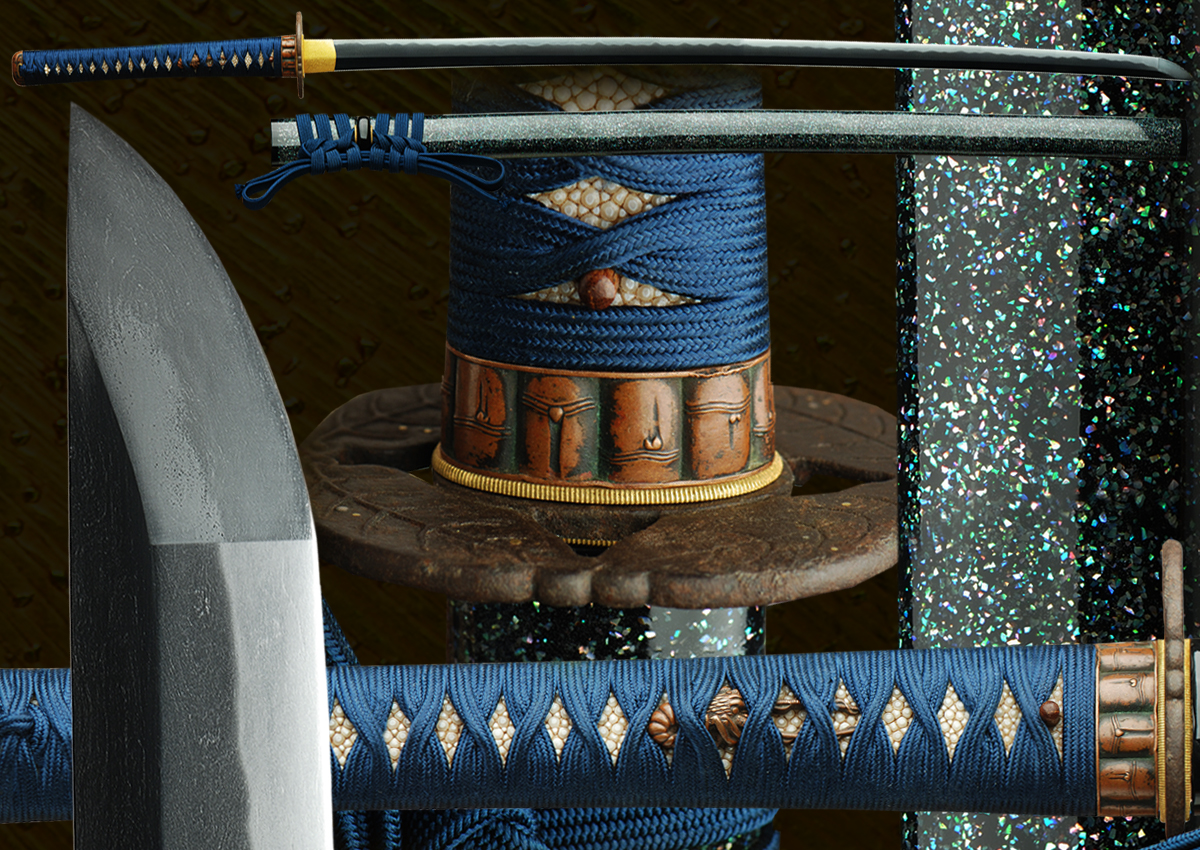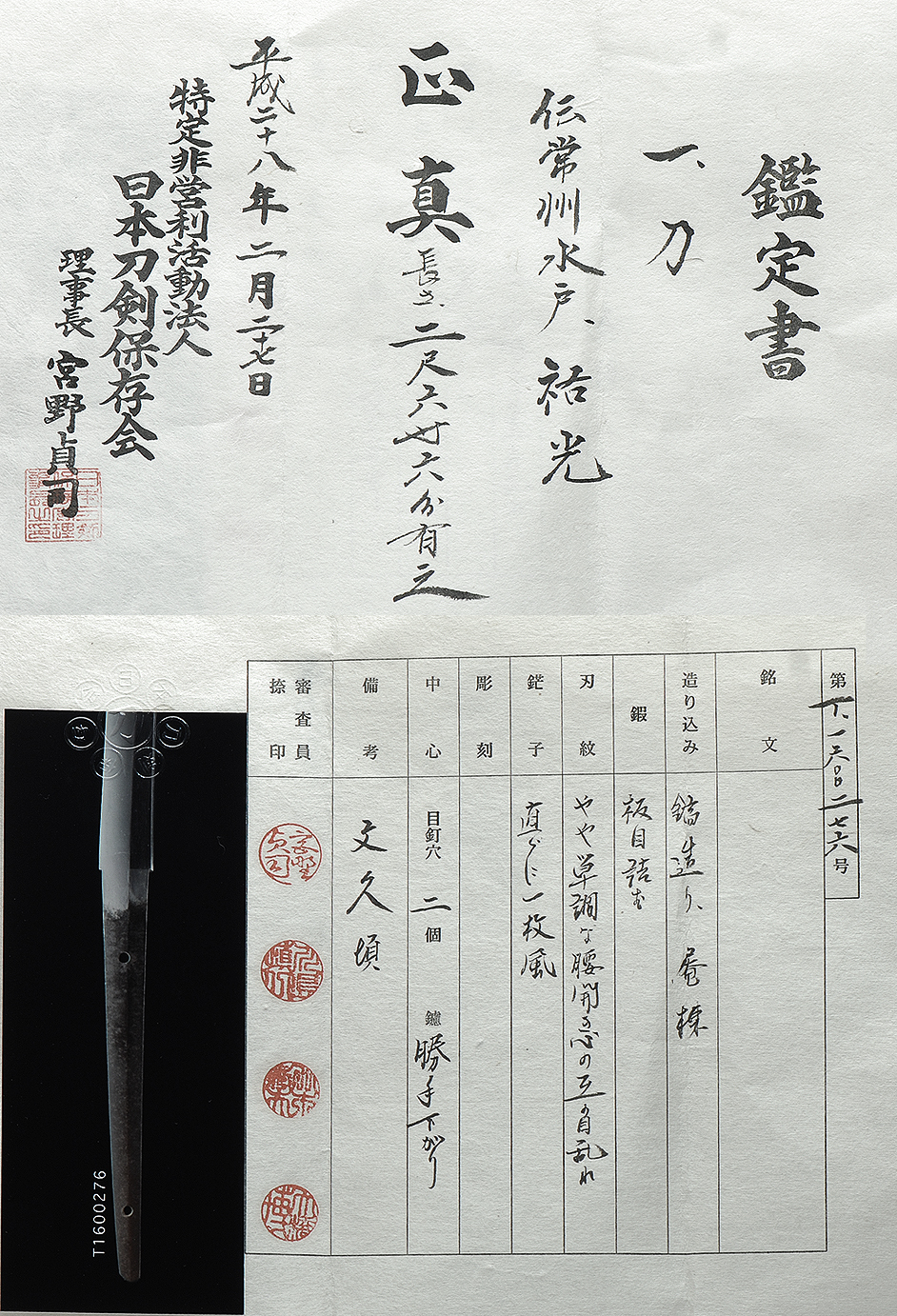A beautiful katana in the tradition of the Bizen school this sword exemplifies the late Bizen school of the Shinshinto era. As you can see in our new High Resolution photographs the hamon is an active mixture of large midare/gunome with an overall elegant shape. There is ara-nie in abundance and hotsure. The boshi is a sugu that tends to ichimai on one side. A very nice feature to study. The hada is a ko-itame with mokume mix and ji-nie appears, a beautiful tight hada to accentuate this glowing hamon. The sword has a wonderful curvature and the overall sugata suggests a time forgotten. A long sword at 31+” katana like this one is not always easily found in flawless condition.
The swordsmith:
SUKEMITSU (祐光), Ansei (安政, 1854-1860), Hitachi – “Suifu ni oite Yokoyama Sukemitsu saku” (於水府横山祐光作), “Mito-jū Sukemitsu kore o tsukuru” (水戸住祐光造之), “Suifu-jū Yokoyama Fujiwara Sukemitsu saku” (水府住横山藤原祐光作), real name Yokoyama Kajūrō (横山嘉十郎, the first name can also read Yoshijūrō), he is also listed with the first name Kijūrō (喜十郎), he was born in the third year of Bunsei (文政, 1820) as third son of a certain Taguchi Gon´emon (田口権右衛門) in Edo, there he studied under a not further specified Yokoya smith and was allowed the use the family name Yokoyama (横山), in the second year of Kaei (嘉永, 1849) he was employed by the Mito fief (水戸藩) by recommendation of Norikatsu (徳勝) and received a stipend for the support of seven persons, he died on the 13th day of the seventh month Meiji six (明治, 1873) in his house in Mito´s Hachiman (八幡) at the age of 54, suguha, gunome-midare, chūjō-sakuThe koshirae is clean and fundamental with menuki of crayfish against a beautiful pattern of Same. The tsuba is iron and very strong. An incredible full lacquered saya of crushed Abalone shell to finish the mounts in true samurai style. The blade is in full polish.
The koshirae:
These are clean solid mounts with copper menuki of Ebi/lobster against a beautiful pattern of Same. The tsuba is a clean design of bamboo leaves. The fuchi and kashira are also copper in a bamboo motif. An incredible full lacquered saya of crushed Abalone shell to finish the mounts in true samurai style. The blade is in full polish and is fully restored adding to its overall value. The Sageo is in blue to match the tsuka ito. The habaki, seppa and shitidome are all finished in a gold patina to match.
- Mei: Mumei, Attributed to Jôshû Mito, Sukemitsu (伝常州水戸、祐光)
Date: Edo (1800’s) - Nagasa: 31-3/4inches
- Sori: 10.0 mm
- Width at the ha-machi: 30.7 mm
- Width at the yokote: 20.5 mm
- Thickness at the mune-machi: 8.3 mm
- Construction: Shinogi zukuri
- Mune: Iori
- Nakago: Ubu
- Kitae: Ko-Itame
- Hamon: Midare Gunome
- Boshi: sugu that tends to ichimai
- Condition: New polish
Asking price: $12,600.00
Sale price: $8,450.00 (sale ends 2/10/17)
Email us if your interested in this item and remember to include the order number for this item: fss-727.
kantei-sho (鑑定書) – Appraisal katana (刀)
Den Jôshû Mito, Sukemitsu (伝常州水戸、祐光)
shôshin (正真) – Authentic
nagasa 2 shaku 6 sun 6 bu kore ari (長さ二尺六寸六分有之) – Blade length ~80.6 cm
Heisei 28 nen 2 gatsu 27 nichi (平成二十八年二月二十七日) – February 27th 2016
Non Profit Organization (特定非営利活動法人)
Nihon Tôken Hozon Kai (日本刀剣保存会) – NTHK
Board Chairman (理事長): Miyano Teiji (宮野貞司)
No T-1600276
meibun (銘文) – Signature: Mumei
tsukurikomi (造り込み) – Shape: shinogi-zukuri, iori-mune
kitae (鍛) – Forging: dense itame
hamon (刃紋) – Hardening: gunome-midare that tends to koshi no hiraita
bôshi (鋩子) – Hardening in tip: sugu that tends to ichimai
chôkoku (彫刻) – Engravings:
nakago (中心) – Tang: mekugi-ana (目釘穴) 2, yasurime (鑢): katte-sagari
bikô (備考) – Remarks: around Bunkyû (文久, 1861-1864) shinsa’in natsu’in (審査員捺印) – Seals of Judges: 4 seals
For Sale

























